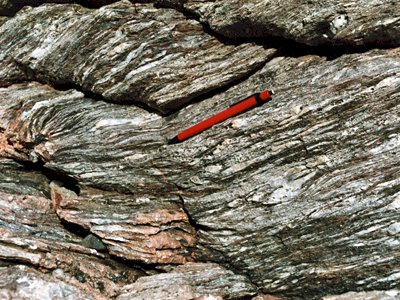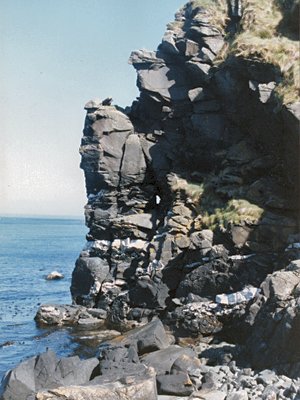Earth Science Conservation Review
| Escort Port | Antrim |
| Site Type: | Cliff, Coastal section |
| Site Status: | ESCR |
| Grid Reference: | D227407 |
| Google maps: | 55.19858,-6.07302 |
| Rocks | |
|---|---|
| Rock Age: | Precambrian (Dalradian) |
| Rock Name: | Owencam Formation, Torr Head Formation |
| Rock Type: | Phyllite, Schist |
| Interest | |
Summary of site:
The coastal section at Escort Port gives access to rocks of the Argyll Group of the Middle Dalradian, ancient rocks formed 600 million years ago. The divisions seen are the Owencam Formation and part of the overlying Torr Head Formation.
On the path to the shore schists and schistose grits are seen in combination with stained quartz mica schists and phyllites. All of these rocks show strong mineral alignment, giving a ‘grain', a consequence of regional metamorphism and the main reason for their tendency to weather into flags. The rocks bear the marks of at least four periods of deformation, reflected in four fold systems with related cleavage planes (alignments of minerals caused by metamorphism along which the rocks split easily). On the coast, in the cliffs and in blocks lying on the shore, are more coarse mica schists and striped quartz-rich rocks (formed in the plane of one of the cleavages). All these rocks belong to the Owencam Formation.
At the southern end of Escort Port are metamorphosed limestones with colours ranging from white through pale grey to grey-blue. Thin green beds (indicators of low grade metamorphism) also occur here. A cliff of altered basic igneous intrusions, now a metabasite, defines the southern access limit. This sequence is part of the Torr Head Formation. Although the Torr Head rocks appear to lie below the Owencam Formation, they are actually later and this entire section is part of an overturned fold.
In the Middle Dalradian, during Owencam times, on the coast of the supercontinent of Laurentia, the Earth's crust was beginning to stretch on the divide between two deep convection cells circulating in the mantle. The earlier, stable coastal basins gave way to less predictable conditions with sands and grits accumulating on the shallow coastal shelf. The shallow water limestones of the Torr Head Formation followed. The thinning of the crust eventually led to tears in the lime sediments of this sea bed and volcanic rocks broke through.
Around 130 million years later, in the Grampian phase of mountain building, this entire mass of sediments, by now deeply buried, were caught in the titanic forces of continental collision and heated in the complex zone of deformation that created the metamorphic rocks and their structures seen at Escort Port. It was at this time that the immense fold that turned these rocks upside down, the Altmore Anticline, was formed. Such is its size that it continues into Scotland to the east and the Sperrin Mountains to the west. On the scale of alteration of regionally metamorphosed rocks, the Dalradians of north-east Antrim are considered low grade (lightly altered).
There are no current threats to this important coastline.
On the path to the shore schists and schistose grits are seen in combination with stained quartz mica schists and phyllites. All of these rocks show strong mineral alignment, giving a ‘grain', a consequence of regional metamorphism and the main reason for their tendency to weather into flags. The rocks bear the marks of at least four periods of deformation, reflected in four fold systems with related cleavage planes (alignments of minerals caused by metamorphism along which the rocks split easily). On the coast, in the cliffs and in blocks lying on the shore, are more coarse mica schists and striped quartz-rich rocks (formed in the plane of one of the cleavages). All these rocks belong to the Owencam Formation.
At the southern end of Escort Port are metamorphosed limestones with colours ranging from white through pale grey to grey-blue. Thin green beds (indicators of low grade metamorphism) also occur here. A cliff of altered basic igneous intrusions, now a metabasite, defines the southern access limit. This sequence is part of the Torr Head Formation. Although the Torr Head rocks appear to lie below the Owencam Formation, they are actually later and this entire section is part of an overturned fold.
In the Middle Dalradian, during Owencam times, on the coast of the supercontinent of Laurentia, the Earth's crust was beginning to stretch on the divide between two deep convection cells circulating in the mantle. The earlier, stable coastal basins gave way to less predictable conditions with sands and grits accumulating on the shallow coastal shelf. The shallow water limestones of the Torr Head Formation followed. The thinning of the crust eventually led to tears in the lime sediments of this sea bed and volcanic rocks broke through.
Around 130 million years later, in the Grampian phase of mountain building, this entire mass of sediments, by now deeply buried, were caught in the titanic forces of continental collision and heated in the complex zone of deformation that created the metamorphic rocks and their structures seen at Escort Port. It was at this time that the immense fold that turned these rocks upside down, the Altmore Anticline, was formed. Such is its size that it continues into Scotland to the east and the Sperrin Mountains to the west. On the scale of alteration of regionally metamorphosed rocks, the Dalradians of north-east Antrim are considered low grade (lightly altered).
There are no current threats to this important coastline.
| Enlander, I., Dempster, M. & Doughty, P., 2025. Escort Port, County Antrim, site summary. [In] Earth Science Conservation Review. https://www.habitas.org.uk/escr/summary.php?item=156. Accessed on 2025-10-23 |
| Previous Site | Next Site |


